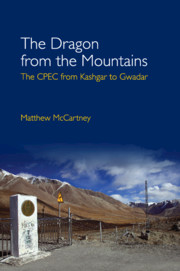Book contents
- Frontmatter
- Dedication
- Contents
- List of Maps and Figures
- List of Tables
- Preface
- Acknowledgements
- 1 Introduction
- 2 Big Infrastructure: Big Problems or Big Benefits?
- 3 CPEC Spillovers Rippling Outwards
- 4 Through the Eyes of Who? Evaluating the Success of the CPEC
- 5 The Dragon Uncoils: Special Economic Zones (SEZs) from Shenzhen to Africa
- 6 The Dragon's Embrace: Pakistan–China Trade Policy
- 7 The Will of the Dragon: The Importance of an Industrial Policy
- 8 Conclusion: The Way of the Dragon or the Way of the Falcon?
- Bibliography
- Index
4 - Through the Eyes of Who? Evaluating the Success of the CPEC
Published online by Cambridge University Press: 06 August 2021
- Frontmatter
- Dedication
- Contents
- List of Maps and Figures
- List of Tables
- Preface
- Acknowledgements
- 1 Introduction
- 2 Big Infrastructure: Big Problems or Big Benefits?
- 3 CPEC Spillovers Rippling Outwards
- 4 Through the Eyes of Who? Evaluating the Success of the CPEC
- 5 The Dragon Uncoils: Special Economic Zones (SEZs) from Shenzhen to Africa
- 6 The Dragon's Embrace: Pakistan–China Trade Policy
- 7 The Will of the Dragon: The Importance of an Industrial Policy
- 8 Conclusion: The Way of the Dragon or the Way of the Falcon?
- Bibliography
- Index
Summary
In the existing CPEC literature, there is little sign of careful thinking about how to measure the success or otherwise of the CPEC using any rigorous method. More common is to use a list of descriptive statistics about the promise of the CPEC and combine it with a mix of laudatory claims about the transformative potential of the CPEC.
The official rhetoric about the CPEC from the Government of Pakistan is that it will transform Pakistan's economy. The former Minister of Planning and Reform, Professor Ahsan Iqbal, gave a speech to the Pakistan–China Joint Cooperation Committee in which he claimed that by 2025 the CPEC will help Pakistan achieve 8 per cent annual growth, increase exports from $25 to $150 billion, raise the tax-to-GDP ratio to 16–18 per cent, investment to 22–25 per cent and domestic savings to 18–21 per cent (Ali et al. 2017: 193). Since the CPEC was announced and the early projects were completed, none of these outcomes has yet come to pass. Between 2012–13 and 2017–18, growth of GDP has remained stuck in the 3–5 per cent per annum range, exports have actually declined from 11 per cent to 7.9 per cent of GDP (to around $22 billion), total investment has remained stagnant at 15–16 per cent of GDP (down from 20 per cent in 2005–6) and domestic savings have declined from 14 to 10 per cent of GDP (Government of Pakistan 2019). Figure 4.1 later in the chapter shows that tax revenue has been rising in the last few years in Pakistan, but, at around 12 per cent of GDP, remains a long way below the government aspiration.
Although the CPEC aspirations have not yet been achieved, it is too early to make any kind of definitive judgement. The CPEC is not even due for completion until 2030. The method in this chapter is to evaluate the CPEC against both this speech and also the more formal claims of the Government of Pakistan. The official government planning document states that ‘The CPEC is a growth axis and development belt featuring complementary advantage, collaboration, mutual benefits and common prosperity’ (Government of Pakistan 2017: 4, emphasis mine).
- Type
- Chapter
- Information
- The Dragon from the MountainsThe CPEC from Kashgar to Gwadar, pp. 78 - 113Publisher: Cambridge University PressPrint publication year: 2021

